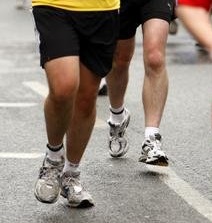Four Things I Have Learned From Running
 IN SHORT: There are lessons to be learned from running that apply to life in general: Pace yourself; Shorten your stride; Swing your arms; Focus on ‘now’.
IN SHORT: There are lessons to be learned from running that apply to life in general: Pace yourself; Shorten your stride; Swing your arms; Focus on ‘now’.
“You have a choice: you can throw in the towel,
or you can use it to wipe the sweat off your face
and keep running.”[Unknown]
(~1100 words, approx 6-9 mins to read)
It’s been a few months since I last wrote to you all, and for that I apologise. I have been making some significant changes in my life and sorting some things out, but more about that another time.
Some of you know I run. Not all the time, obviously – sometimes I walk. Or cycle. Over the last few years I’ve trained for and completed two marathons and more than a dozen half-marathons, and in doing so I’ve learned quite a few lessons from running that are also applicable to everyday life, whether work or pleasure. I’ve picked just four of them for now and, if it’s OK with you, I’d like to share them with you.
They are, in no particular order of preference:
- Pace yourself
- Shorten your stride
- Swing your arms
- Focus on ‘now’
1. PACE YOURSELF
This might sound really, really obvious, but it’s interesting (and sometimes frustrating) how often we ignore it. It was something I learned very quickly when I got back into running, especially when running in organised events. The first few times I’d set off at too optimistic a pace, a pace I wasn’t ready for yet. Perhaps I was buoyed up by race-day excitement and adrenaline, or trying to keep up with those fitter and faster than me. But it doesn’t work – sooner or later I had to slow down, often to a slower pace than I really wanted, to recuperate and make sure I could last the whole race.
In life we can throw ourselves with gusto into a new project, new role, new relationship or other endeavour and the same thing happens; we come to the realisation that we don’t have the skill, training or experience to sustain that level of effort if we are to see it through to the end, or make it a long-term commitment. We need to pace ourselves realistically, whether it’s based on fitness, current level of skill or experience, or just to keep comfortable.
Perhaps I should extend the line to “Pace yourself to finish well,” Personally speaking, when I’m racing I like to run what’s called a ‘negative split’. That means I keep a little in reserve over the first half of the race so I can give myself a boost in the second half and particularly the closing mile or two. Better to start a little slower and accelerate than start too fast and fade away or give up.
2. SHORTEN YOUR STRIDE
When I was a lot younger I did what my wife affectionately refers to as ‘lobbing’ – I walked with over-long strides that meant my head bobbed up and down as I moved along. But if you look at efficient runners you’ll notice something interesting (you will, honestly!); as they take each step, their leading foot touches the ground just as their centre of mass moves directly over it. If your foot lands in front of you as you walk or run, you’re effectively braking a little with each step.
I had to learn that to increase my speed I actually had to shorten my stride – to move forward in smaller but more rapid steps. I learned that trying to take in more with each stride was actually counter-productive. And as you’re probably already thinking, life is a lot like that too. Whether it is a project, role, relationship or something else, we can try to move forward in big chunks simply because we want to feel we’re making progress, ticking boxes, getting through the stages. But taking strides that are too big, especially when there are others involved, can be wholly self-sabotaging.
Shortening your stride is especially useful when the terrain changes. When the gradient increases, your stride should decrease. Or to put it another way, when things get tricky, take smaller steps. This might be easy to realise when you’re going uphill but it’s also very true when you’re going downhill too. It’s easy to see the slope as helpful, as making things easier, as a way of accelerating but if you’re not careful all it takes is one foot wrong and you’re tumbling. Shorten your stride.
3. SWING YOUR ARMS
This one is perhaps slightly less apparent than the first two, but is something I’ve learned is very, very helpful especially when tired.
A lot of people think running is all about your legs and everything else just moves along to balance things out while you focus on keeping one foot going in front of the other. But take a look at a really fast sprinter and watch their arms, observing how they move. They pump their arms forward and backwards in sync with their legs, not just to retain balance or symmetry but because their arm movements actually contribute to their forward momentum.
When you’re running and your legs tire a little, your arm movements reduce too. However, if you actually focus on moving your arms more, your legs follow suit! It sounds counter-intuitive, but try it and you’ll find it works! In some cases I’ve come across, knee and other leg pains have been corrected simply by changing a person’s arm-swing.
Often we can get bogged down in a project or other activity in our lives because the core elements or ‘critical path’ seem slow. But we need to remind ourselves that sometimes shifting our attention to some supposedly supporting or less relevant strand of effort can actually help, and it may be that those fringe elements were actually holding things back. Once they’re corrected, things begin to flow again.
4. FOCUS ON ‘NOW’
This is probably one of the most important things I’ve learned from running. In the early stages of a long race it’s all too easy for your mind to wander to the long stretch of miles you have yet to cover, and to feel tired simply at that thought of all that effort. And it’s easy in the last few miles to start trying to convince yourself to ease up because you’ve done so many miles already. It’s easy at the bottom of a hill to see the whole hill looming and to despair, even before the road begins to climb.
The most powerful thing you can do in life, not just when running is simply to focus on exactly what you’re doing *right now*. If your pace is off, correct it. If your form is off, correct it. If your stride is too long, shorten it. Just focus on one step at a time and compare what’s actually happening right now with what should be happening right now and close the gap between the two. Nothing more than that.
It’s such a powerful lesson because if you focus on keeping yourself on track just for now, those ‘now’s add up from beginning to end.
So there you have it. Four of the many things I’ve learned from running:
They are, in no particular order of preference:
- Pace yourself
- Shorten your stride
- Swing your arms
- Focus on ‘now’
Pick one and let me know how you get on…
Until next time,
![]()

